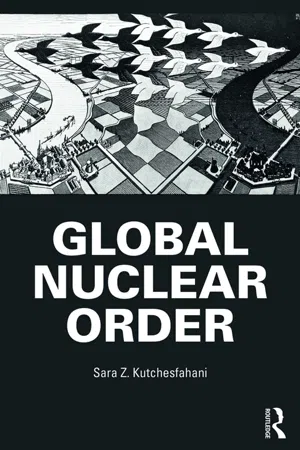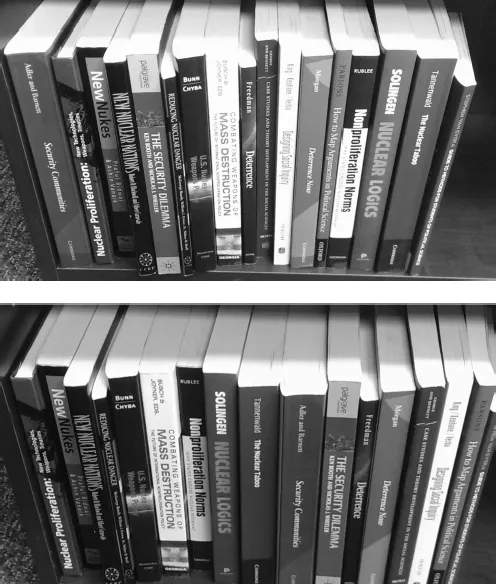![]()
1
What is the global nuclear order and why does it matter?
Chapter learning objectives
- Discuss the concept of nuclear order and nuclear disorder
- Summarise the key attributes of nuclear order and nuclear disorder
- Explain how global nuclear order affects international politics
- Examine the importance of global nuclear order
This chapter begins by introducing the book’s two main themes: (1) the global nuclear order/disorder paradigm, and (2) the importance of perspective in our understanding of the paradigm. Throughout, the chapter poses questions, encouraging the reader to pause for a moment, reflect on the question posed, and realise that there are potentially multiple perspectives to consider before providing a thoughtful response. The chapter identifies theories of global nuclear order – particularly those from William Walker and Nicola Horsburgh – the two eminent global nuclear order scholars. Moreover, it conceptualises global nuclear order and global nuclear disorder by summarising their key attributes. This chapter draws extensively upon Walker and Horsburgh’s definitions of global nuclear order/disorder and builds on both scholars’ work by providing a succinct overview of this complex issue area as well as a concise definition of the term(s). For the purposes of this book, global nuclear order henceforth refers to the process by which nuclear weapons affect the world order. In the introduction, the world order was defined as a system controlling events in the world – in particular, a set of arrangements established internationally for maintaining global political stability. The chapter explains how global nuclear order affects international politics. Notably, that the victors of the Second World War (the United States, Russia, United Kingdom, France, and China) are not only the five permanent members of the United Nations Security Council (UNSC), but they also happen to be the recognised nuclear weapon states. Indeed, these five states that make up the UNSC comprise the only United Nations (UN) body with the authority to issue binding resolutions to member states – in other words, take charge of decisions that impacts international peace and security, and the world order. Based on this alone, it is quite clear that the recognised nuclear weapon states, by virtue of owning a nuclear weapon arsenal, do indeed play a significant role in international politics and world order.
Moreover, this chapter examines why a study on global nuclear order is important. With today’s constantly changing reality bringing nuclear issues to the forefront of international politics and international newspapers, an understanding of global nuclear order can be helpful to those trying to unravel the complexities of nuclear weapons policy and their role in shaping the current global political order. Simply put, the global nuclear order provides a useful framework to study because it provides a lens through which to analyse and understand the way in which global nuclear politics affects the world order. Finally, throughout, the chapter emphasises the significance of perspective in our understanding of global nuclear order. Specifically, on how one views the importance of nuclear weapons in international politics. In other words, reflecting on the extent to which nuclear weapons can be viewed as both a source of international peace, security, and stability (therefore order), and also contribute to global instability and anarchy (therefore disorder).
Order and perspective
We begin this section with a mental exercise. Consider the word “order”. First, consider it from a theoretical perspective. In other words, how might you describe “order” in theory? Specifically, what would a theoretical perception of order entail? (Note, there is likely to be more than one way to explain order in theory, so make a note of everything that comes to mind.) Now, consider it from a practical perspective. How would “order” be described in practice? What practical considerations might you ascribe to order? (As before, there is likely to be more than one way to explain order in practice, so make a note of everything that comes to mind.) Is there a difference between the two perspectives? More specifically, does the conceptualisation of “order” depend on perspective? These two words – “order” and “perspective” – are crucial terms to define from the outset given that they are two of the main underlying themes and concepts explored throughout this book.
Within International Relations (IR) theory, there is no single universally accepted definition of world order simply because there is no agreement on the appropriate conception of order. Indeed, the concept of “order” in IR can mean anything from collective security to anarchy, (uni)polarity to world government, hegemony to balances of power.1 Equally, “order” in international politics can mean anything from structure to management, organisation to discipline, control to stability. For IR realists, order is temporary given the anarchic, self-help international system. For constructivists, order is created via “shared meaning and collective intentionality” that frames the international society.2 By focusing on the characteristics of the international society, constructivism provides a framework to help us understand how order is created, strengthened, and, sustained. Within this theoretical lens, Hedley Bull’s articulation of order in his 1977 The Anarchical Society: A Study of Order in World Politics – in which he argues for the existence of an international society – is the best starting point (and, is the most frequently cited).3 He describes order as “a pattern of activity that sustains the elementary or primary goals of the society of states, or international society”.4 These goals refer to life, truth, and property; specifically, protection against violence, honouring agreements, and maintaining the protection of possessions and property. And, according to Bull, it is the great powers (specifically, the nuclear weapon states) who have the responsibility to maintain world order.5
Below are two images depicting the same display of books, but in a different order. This brings us to the second mental exercise of the chapter.
Which of the images seem more orderly? And, what is the order? Image one is arranged alphabetically by author; image two is arranged alphabetically but per subject area, which raises the issue of perspective. What can be orderly from one perspective may be disorderly from another perspective. Specifically, an arrangement of books that is orderly vis-à-vis one purpose (i.e., finding a book by a particular author – image one) may be disorderly vis-à-vis another purpose (i.e., finding a book on a particular subject – image two).6
Over the years, various academics have proffered their own variations and perspectives of order, indicating its highly contested and conflicted nature, as shown in Text Box 1.1.
The same, however, cannot be said of the term “nuclear order”. Apart from a few scholars, notably Professor William Walker of the University of St. Andrews and Dr Nicola Horsburgh of King’s College, London, and an exchange of ideas in a special issue of the 83rd volume of the International Affairs journal in 2007, those who use the term “nuclear order” typically use it when describing its erosion, without adequately defining it.7 The term was first used in an academic context in 1977 by Michael Mandelbaum, who wrote an article entitled, “International Stability and Nuclear Order: The First Nuclear Regime”, yet he failed to provide a definition or even description of the term, in spite it being used in the title of the chapter.8
Text box 1.1 Definitions of (world) order
| Raymond Aron (1965) | Conditions of world order would mean: “under what conditions would men (divided in so many ways) be able not merely to avoid destruction, but to live together relatively well in one planet” (Hoffman, “Report of the Conference on Conditions of World Order”: 2). |
| Hedley Bull (1977) | “A pattern of activity that advances a goal” (Bull, The Anarchical Society: 8). |
| Stanley Hoffmann (1987) | “The norms, practices, and processes that ensure the satisfaction of the basic needs of the social group in question” (Hoffman, “Is There an International Order?”: 85). |
| Nicholas J. Rengger (2000) | “Order is the term we give for the set of rules, constitutive and regulative, which together make up the practices of shared meaning and collective intentionality that frame a particular social practice” (Rengger, International Relations: 84). |
| Muthiah Alagappa (2003) | “A formal or informal arrangement that sustains rule-governed interaction among sovereign states in their pursuit of individual and collective goals” (Alagappa, “The Study of International Order”: 39). |
| Andrew Hurrell (2007) | “We are […] not dealing with a vanished or vanishing Westphalian world […] but rather with a world in which solidarist and cosmopolitan conceptions of governance coexist, often rather unhappily, with many aspects of the old pluralist order” (Hurrell, On Global Order: 9). |
Within the policy community, “nuclear order” has recently gained prominence over fears that the order is eroding. In 2008, an 18-member group of “eminent persons” comprising global representatives from government, non-governmental organisations (NGOs), academia, and energy corporations, delivered their International Atomic Energy Agency (IAEA)-commissioned report on “Reinforcing the Global Nuclear Order for Peace and Prosperity”. The report called for a “reinvigorated global nuclear order that will reduce risks”.9 Even though the challenges to the global nuclear order were outlined (for example, the threat of nuclear terrorism, the nuclear ambitions of the Democratic People’s Republic of Korea and Iran, the spread of dual-use technology, and the slow progress on nuclear disarmament), the “reinvigorated global nuclear order” was not defined. It was simply implied. In the same year, the then Director General of the IAEA, Dr Mohamed ElBaradei, equally warned: “We are at a crucial juncture. The system is faltering. […] We need to start serious work toward a new collective security paradigm”.10 A year later, in his farewell address to the IAEA, he stated, “We face continuing major shortcomings […] which, if not addressed, could put the entire non-proliferation regime at risk”.11 Equally, Harvard University Belfer Center’s Graham Allison and former President of Mexico and chair of the aforementioned IAEA-commissioned report Ernesto Zedillo, opined on the pages of The Boston Globe that the “architecture that has for four decades held back powerful pressures for the proliferation of nuclear weapons is shaking. […] We risk the catastrophic collapse of the global nuclear order”.12 But, as before, Allison and Zedillo did not provide a definition of the global nuclear order – it was, again, implied.
What, then, is the global nuclear order? And, if it is eroding, faltering, and shaking, what needs to be done to ensure its stability? Even though the term is loosely thrown around, both in academia and policy, very few academics or policy practitioners have taken the time to provide a definition and conceptualisation of the term. In theory, it may be understood as a way in which nuclear weapons account for the general political stability/status quo, but in practice, the parameters get even more blurred, which is where we turn to in the next section.
Conceptualising global nuclear order
Before drawing on the perspectives of William Walker and Nicola Horsburgh – the two eminent nuclear order scholars – on global nuclear order, let us engage in the third me...

